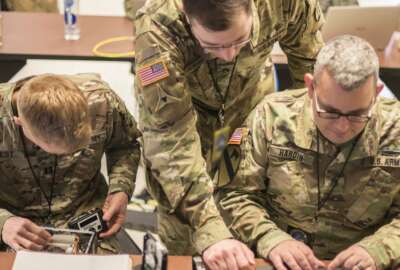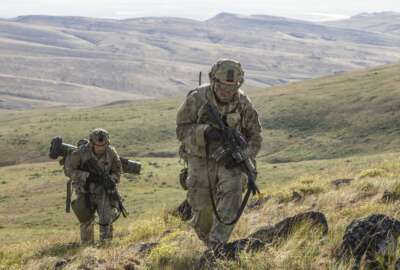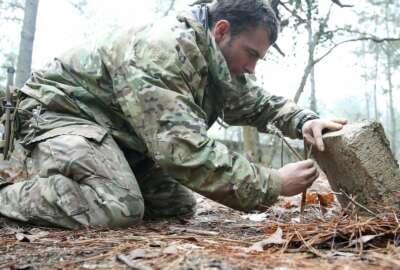
Army plans next big migration to new HR system
The Army is focusing on data accuracy as it prepares to move the rest of its uniformed workforce into its centralized HR IT system, known as IPPS-A.
The DoD Reporter’s Notebook is a weekly summary of personnel, acquisition, technology and management stories that may have fallen below your radar during the past week, but are nonetheless important. It’s compiled and published each Monday by Federal News Network DoD reporters Jared Serbu and Scott Maucione.
Is your pay correct? The Army wants to make sure as it moves to IPPS-A
The software program aimed at consolidating all of the Army’s payroll functions is planning for a huge milestone at the end of the year, but it needs soldiers’ help to make the process as smooth as possible.
The service will roll out the next phase of its Integrated Personnel and Pay System-Army (IPPS-A) on Dec. 21, encompassing more than 1 million soldiers into the program. This phase will bring in the reserve and active duty components.
However, the Army needs to ensure its payroll data for soldiers is solid and therefore is calling on troops to double check their personal information in the system.
“You’re only as good as the data that’s sitting inside of your system,” Roy Wallace, the Army assistant deputy chief of staff for personnel told reporters. “As we move forward in this we need soldiers to look at their data and make sure it’s right. Because when it when the data is bad, the outcomes are bad. We’ve got a concerted effort reaching out to each and every soldier to get in and look at their data and make sure it’s right.”
With the current decentralized pay systems soldiers are unable to see all the details in their personnel files. Soldiers will need to meet with their local unit personnel office to ensure things like salary, family size and other important information are up to date.
Since some paperwork may need to be processed in order to make sure those details are correct, the Army is encouraging soldiers to meet with their personnel office as early as they can before the switch.
IPPS-A will eventually be the Army’s one-stop-shop for all human resources related matters from pay and benefits to job selection.
The service already transitioned members of the National Guard over to the new program.
“We have every state and territory active in IPPS-A today, so more than 330,000 National Guard soldiers are all completely inside IPPS-A and we divested from 54 versions of old army systems,” Col. Gregory S. Johnson, IPPS-A functional management division chief, said. “Those systems were early 80s technology that were put in place that the Guard had upgraded in each individual state. Now that is sunsetted. That is gone.”
Johnson said many of issues with IPPS-A during the earlier National Guard switch were based on data.
“The 54 retired pay systems had different code baselines, they had different data structures,” he said. “We had some issues pulling that data over and getting it clean. As we went live, and we focused tremendous amount of effort on making sure that data was correct.”
Johnson said that experience is a big part of why the Army is asking soldiers to confirm their current information. — SM
GAO finds ‘distortions’ in how private military housing firms are compensated
Some of the military’s privatized housing providers may be getting something of a windfall because of a quirk in how DoD is reimbursing them for recent cuts in military housing allowance rates, while others appear to be getting shortchanged, according to a new review by the Government Accountability Office.
The root of the issue goes back to 2015, when DoD proposed, and Congress agreed, to start requiring servicemembers to pay some of their own housing costs in order to cut costs in its personnel budget. Those cuts took full effect last year, reducing the housing allowances they’d otherwise get by 5%.
But even as the reductions were first taking place, Defense officials worried about the effects they would have on their on-base housing providers. Those firms, after all, had planned their real estate management operations on a predictable revenue stream that was now being cut by 5%. Congress responded by ordering the military services to make up the 5% difference and pay it directly to their housing companies, with half that amount dedicated to underfunded projects.
But it’s possible lawmakers didn’t think fully think through the reimbursement methodology they directed. The Basic Allowance for Housing (BAH) cuts — or “cost shares” — as DoD prefers to call them, are a fixed dollar amount no matter where a servicemember is stationed. The reimbursements to housing providers, on the other hand, are tied directly to local market-based BAH rates. And 5% of BAH in the San Francisco Bay Area is very different from 5% of BAH at Camp Lejeune.
What that means in practice, according to GAO, is that almost all of the reimbursements were either above or below what the companies needed to actually make them whole as a result of the original BAH reduction. Thirty-two housing projects got more money than was needed to offset those cuts — six of them by $1 million or more. On the other side, 48 projects got less money, and 6 were shortchanged by $1 million or more.
“By requiring BAH reductions to be reduced by the national BAH rate and the congressionally mandated payments to privatized housing projects be based on the local BAH rate, Congress created unintended distortions in payments to the projects,” the watchdog noted.
For its part, DoD told GAO it simply did what Congress ordered it to do, both when it came to calculating the BAH reductions and the reimbursements to housing companies. But Defense officials told GAO reviewers it does make some sense to peg the BAH reductions to a nationwide, fixed dollar figure.
According to the report, “DoD noted [that[ implementing reductions in this way is equitable, because it ensures that the amount of the reduction (i.e., the amount that comes ‘out of pocket’ from servicemembers’ total compensation) is the same across any given pay grade and dependency status, regardless of where in the United States a servicemember is stationed.” —JS
Air Force readies civilian career development
The Department of the Air Force is offering more than 30 educational development programs for civilian employees for the 2022 cycle.
The programs prepare civilian Air Force and Space Force workers for the demands of their job and enrich their resumes. The courses range from leadership to academic pursuits.
“Civilian force development came about as a way for the department of the Air Force to invest in people and actively demonstrate a commitment to deliberately developing our civilian workforce,” Jana Ramon, an Air Force Personnel Center human resources specialist told Federal News Network. “We rely on military and civilian leaders to have the right competencies to accomplish the mission and win any high end fight. Leading in an ever changing environment is going to require critical thinking and strategic leadership skills. The courses that we offer help hone these skills and prepare our civilian leaders to work shoulder to shoulder with those military counterparts to ensure continuity of operations.”
The courses civilians can apply for are sometimes made for military service members or may be taught in a more casual setting like the National Defense University.
“Participation in developmental programs positively impacts retention and is one of the ways the department invests in its people,” Becky Venters, chief of the Civilian Leadership Development Program said.
The courses are broken into four subject areas: Developmental education, academic/fellowships, leadership seminars and experiential assignments.
“The experiential assignments are more of the on-the-job-type development still at an enterprise leadership perspective,” said Craig Pearson, the Air Force Civilian Strategic Leader Program manager. “The intent is still the same, to try to find that right person at the right time to develop those competencies, to increase the professional development and accomplish the mission. Those who are interested in these developmental experiential assignments have to first apply to the program — it’s competitive.”
Those interested for all the programs must send in their applications by Feb. 26. — SM
Copyright © 2024 Federal News Network. All rights reserved. This website is not intended for users located within the European Economic Area.
Jared Serbu is deputy editor of Federal News Network and reports on the Defense Department’s contracting, legislative, workforce and IT issues.
Follow @jserbuWFED
Scott Maucione is a defense reporter for Federal News Network and reports on human capital, workforce and the Defense Department at-large.
Follow @smaucioneWFED






